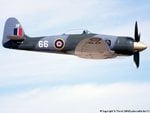Yes you are correct:evangilder said:Didn't they later use the Centaurus for the Hawker SeaFury?
Seafury F.B. Mk.11
Crew 1
Power plant One 2,550 h.p. Bristol Centaurus 18
eighteen cylinder radial air-cooled engine
Armament Four 20mm Hispano Mk.V cannon.
Eight 60lb rockets or 2,000lb of bombs
Maximum speed 460 m.p.h. at 18,000ft.
Wing span 38ft 4¾in.
Length 34ft 8in.
Height 14ft 7½in.
http://www.slug.balancer.btinternet.co.uk/aircraft/seafury/seafury4.htm
The Hawker Sea Fury Carrier borne fighter-bomber was the British Fleet Air Arm's last piston-engined fighter, developed during WWII it did not see service with the Fleet Air Arm until after the war. It was arguably the fastest piston powered aircraft ever manufactured.
It was a development from the Hawker Tempest, itself a development of the Hawker Typhoon. Originally, the Hawker Fury was designed by Sidney Camm in 1942 under F.2/43 specification, to provide the RAF with a lightweight replacement for the Tempest II.
On 23 June, 1942, Luftwaffe Pilot Oberleutnant Arnim Faber erroneously landed his Focke-Wulf Fw 190A-3 fighter at RAF Pembrey, apparently having mistaken this airfield for a Luftwaffe channel coast airfield. The British were thereby presented with a working example of the Fw 190 fighter, which had been giving the RAF an extremely difficult time. The Hawker Fury design was a direct result of the examination of Faber's Fw 190A-3. Examination of Faber's aircraft was largely responsible for the preparation of Specification F.6/42, which called for a new, high-performance fighter.
The design was modified in 1943 to meet a Royal Navy specification (N.7/43) for a carrier-based interceptor and named the Hawker Sea Fury. Hawker was designated to work on the land-based version, and responsibility for the naval conversion was assigned to Boulton-Paul Aircraft Ltd. of Wolverhampton.
Early in 1944, a revised naval specification, N.22/43, supplanted N.7/43. and in April 1944 contracts were placed for 200 F.2/43 planes for the RAF and 200 N.22/43 planes for the Fleet Air Arm. The first Sea Fury prototype, SR661, flew on 21 February, 1945. It was powered by a Centaurus XII engine driving a four-bladed propeller. This airplane had a deck arrester hook under the rudder, but retained fixed wings. The second Sea Fury prototype, SR666, was powered by a Centaurus XV driving a five-bladed propeller and was a fully navalized aircraft with folding wings. The prototype Sea Fury SR661 was subsequently tested for its suitability as a naval fighter, and in deck landing trials, at the A&AEE Boscombe Down in May 1945. Tests were still underway as the Japanese surrendered in August 1945.
With the end of the Second World War, the RAF cancelled all production contracts for the Fury, deciding to concentrate all of its future efforts on jet fighters. The Royal Navy reduced its order for Sea Furies to 100 aircraft, and canceled the Boulton-Paul contract in its entirety.
The first production aircraft - a Mark 10 which was a carrier-based version, with folding wings- did not make its initial flight until September 1946. Although originally intended to serve with both the RAF and FAA, the RAF order was cancelled at the end of the war. The first deck trials with Sea Fury TF898 began aboard HMS Victorious during the winter of 1946-47. The Mark 10 was approved for carrier operations in Spring 1947, and five Fleet Air Arm squadrons were then equipped with the Sea Fury. The Mark 10 was followed by the Mark 11 fighter-bomber - 615 of these were eventually delivered to the Navy. It became the Fleet Air Arm's principal single-seat fighter and remained so until the introduction of the Sea Hawk jet fighter in 1953.
The Sea Fury served throughout the Korean War, replacing the Seafire, which was not really built for carrier operations, being too fragile.
The Sea Fury was used by the FAA, Canada, Holland, Australia, and other countries including the Iraq Air Force. A total of 75 Sea Furies served with the Royal Canadian Navy(R.C.N.) between 1948 and 1956. All flew from the Aircraft Carrier HMCS Magnificent in 871 squadron.
http://www.fleetairarmarchive.net/Aircraft/Seafury.html









